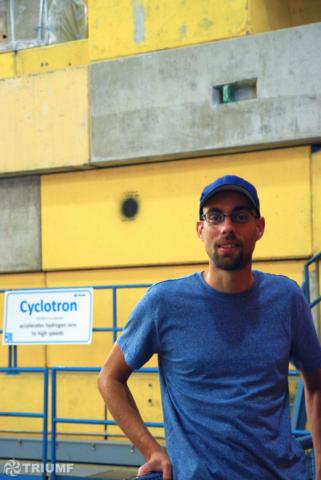
Marie-Curie International Outgoing fellow Tobi Junginger knew he needed to see the bigger picture to grasp the small details. This made TRIUMF the obvious choice for the first portion of his European-Union funded fellowship. The German native will call Vancouver home for two years while he conducts research on accelerators with the RF/SRF department.
Following his experience abroad, Junginger will return to Germany to complete a second research stint as a part of the fellowship. He aims to apply his acquired knowledge locally, at his European host institution Helmholtz-Zentrum Berlin (HZB).
Looking for the bigger picture
Junginger has years of experience working in the superconducting radio frequency (SRF) community. The equivalent of a master’s degree in Physics with a specialized thesis in in Space Sciences lead Junginger to CERN, where he did his PhD on the fundamentals of SRF.
He explained that working in a large environment created a sense of tunnel vision, due to the extreme specialization of his work. “I could try to [develop] more efficient accelerating cavities, but I’ve never seen them really work,” confessed Junginger. “Because CERN is a huge lab, I was [working] in my niche,” said Junginger of his experience.
“Here the group is smaller,” he continued. “So I can participate [more actively].” Junginger was familiar with the work being done on superconducting cavities at TRIUMF. He understood that the opportunity to work in the lab would give him a rare, hands-on experience with accelerators, which would enable him to understand the bigger picture of what he is doing.
Specifically, Junginger noted that the multiple stages of accelerator development at TRIUMF were attractive to him as a young researcher. The ISAC facilities currently house functioning linear accelerators while the newly built ARIEL building is in the commissioning phase for the new electron linear accelerator (e-linac). “I can see everything,” explained Junginger.
This overview will enable him to understand the intricacies involved in creating low-loss superconducting cavities. The hands-on, experimental environment will encourage thinking beyond the theories to understand the technology and its fundamental limitations.
“There’s the state-of-the-art; it’s coming quite close to the theoretical limits but we don’t understand everything about it yet,” said Junginger. “We want to investigate … what can be the most effective material for future cavities.”
The intricacies of efficiency
Junginger will be part of an investigation, spearheaded by SRF group leader Bob Laxdal, to conduct a MuSR experiment and explore Nb3SN as an alternative to the commonly used Niobium (Nb) cavities found in most accelerators.
Nathan Shettell, an undergraduate student from the University of Waterloo working with the SRF group this semester, explains how the experiment makes use of muon decays to examine the superconducting ability of new materials.
To understand the effects of a magnetic field on the Nb3SN, they can see at what point the magnetic field penetrates the sample material affecting the muons inside, their decay and subsequently the positron emission. Ideally, as Shettell describes, “the muon lodged in the material won’t feel the effects of the magnetic field,” if it proves to be effective.
In addition, Nb3SN is believed to have a good candidate for superconducting technology as it has a higher critical temperature than pure Niobium. In superconducting cavities, heat is generated from the excess energy of accelerated particles and is cooled with liquid helium. If the Nb3Sn were used, the liquid helium would not need to be as cold to complete this process. This requires less energy, theoretically rendering Nb3Sn a more efficient material to use thus making it particularly attractive for superconducting cavities.
Transferring technology across borders
Global collaboration and knowledge transfer are some of the goals of the fellowship. Junginger is expected to apply the knowledge he gained through this first research experience to HZB, a lab focused on complex material systems, when he joins their team in two years.
Junginger’s pre-existing knowledge of the SRF developments done at TRIUMF and HZB, as well as previous communication with Laxdal and Jens Knobloch (of HZB) in Germany, eased the application process. “I had a great respect for their work,” he said.
“I tailored my application to put these two institutions together.” That‘s the benefit of the tight-knit international SRF community. Global conferences, such as the International Conference on RF Superconductivity that is hosted by TRIUMF in Whistler in Sept 2015, enables communication and collaboration between researchers in the field.
- Kelsey Litwin, Communications Assistant
Photo: Junginger in TRIUMF's Meson Hall
